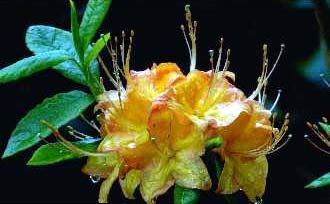Planting ornamental trees and shrubs in containers allows you to vary your landscape at will. It is a wonderful way to show off those in bloom, or provide a change of environment for dormant or sensitive plants.
When potted shrubs or trees flower, it's easy to position them on a terrace or patio where they can best be admired. Similarly, dormant shrubs or plants that are less attractive when not in flower can be moved to an out-of-the-way location.
Choosing Plants and Containers
When planning a garden with potted shrubs or trees, you'll need to consider two things: The first is the plants themselves. Be aware of the overall form - the color and texture of leaves, flowers, and fruit, and the season of bloom. Choose varieties that will mix well with your existing plants and buildings. The second thing to consider is the type of container. Containers come in many shapes and sizes, and in materials such as redwood, terra-cotta and other ceramics, plastic, metal, and concrete. Pick one that is the right size for the plant, and that blends well with the plant itself and with the intended location.
Soil for Potted Plants
The keys to success with this form of gardening are proper soil preparation, and then maintaining the correct balance of soil nutrients, moisture, and container gardening gives you plenty of freedom - you can grow plants that normally would not flourish in your area by preparing a special soil mix for a particular specimen. On the other hand, the health of the soil, and thus the health of the plants, depends on your vigilance.
Container plants have special needs. The soil must drain rapidly because stagnant, soggy soil makes a perfect breeding ground for soil fungi that will destroy roots. To maintain good drainage, you need to restrict the amount of organic matter you add to the soil mix, because organic matter compacts over time. There are several good commercial potting soil mixes available. If you want to make your own, a suitable mix consists of 2 parts good, low-clay topsoil, 2 to 3 parts coarse sand or perlite, and 1 part peat moss.
Watering
As a general rule, container shrubs and trees need frequent watering. Remember that each container holds a fairly small amount of fast-draining soil from which a plant must derive all of its moisture. One dry, windy day can be enough to completely parch the soil in a container. Inspect the soil moisture frequently by digging your finger in just under the surface of the soil; with most plants, if that is dry, it's time to water. Make sure that you soak the soil deeply and thoroughly when you water. You'll know you have succeeded when water begins flowing out of the drain holes at the bottom of the container.
Fertilizing
Because potting mixes are lower in organic matter than typical garden soil, and because frequent watering tends to leach nutrients from container soil more quickly, container shrubs and trees need more attentive fertilizing than similar specimens planted in the ground.
Liquid and timed-release fertilizers are easiest to use. One advantage of liquid fertilizer is that it can readily be diluted if you need to give frequent light feedings rather than one or two heavy doses. Too much fertilizer at once is harmful; you could "burn" the roots or leaves. Timed-release fertilizers are dry granules that are mixed with the potting soil. As the name implies, they slowly release nutrients over a long period of time.
Fertilizing should begin in spring and continue through the growing season. Taper off as fall approaches; you don't want to encourage tender new growth with winter just around the corner.
Planting in Containers
Whether you're planting from scratch or repotting, choose a container that will accommodate the rootball with a little room to spare. There should be enough room for 3 or 4 inches of potting soil around the root ball. The container should be roughly half again as deep as the rootball. Avoid containers that are too large; the extra soil will tend to become damp and stagnant.
Before placing the plant in the container, cover the drain holes with heavy wire mesh screen. Then cover the bottom of the container with an inch or two of crushed rock. Now begin to fill in with potting soil; add enough so that when you rest the root ball on this layer of soil, the top of the root ball is1 to 1 � inches below the lip of the container. After you've placed the root ball in the container, fill in around the edges with potting soil and tamp well. Support with stakes, if necessary, and water thoroughly.
TIPS: HEAT AND COLD
Protect container plants from the extremes of weather. In hot, dry periods, move containers into the shade and check soil moisture daily. Before a freeze, move them under eaves or an evergreen tree to block exposure to the open sky.


